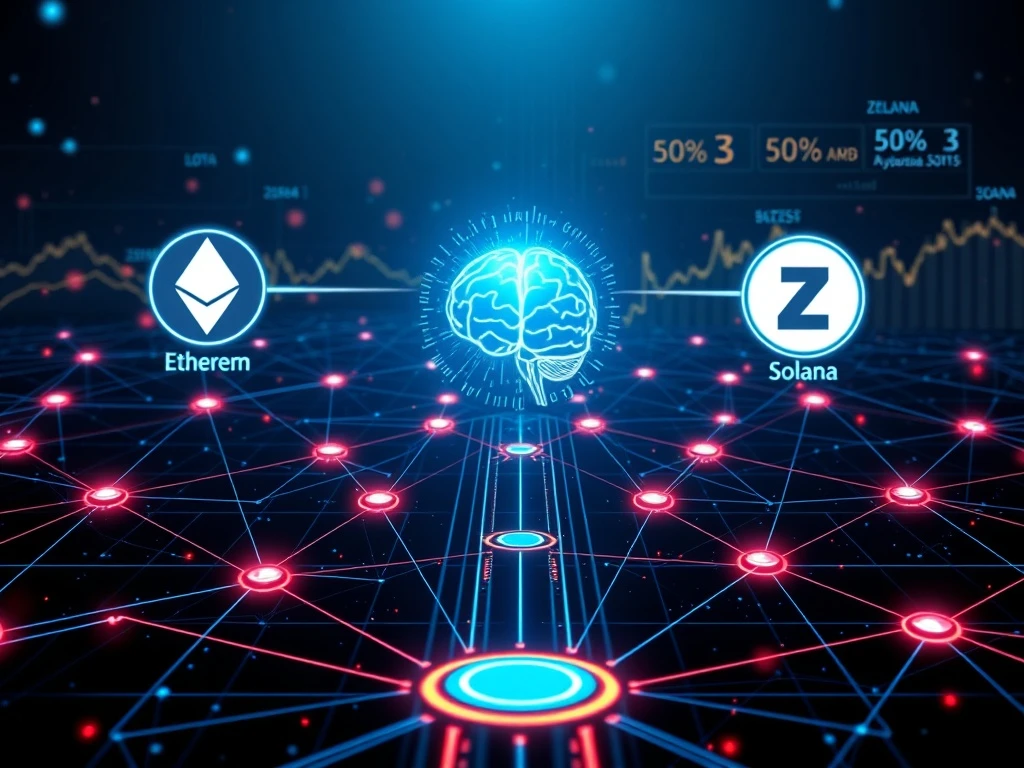Zircuit Unveils Breakthrough Hyperliquid AI Engine, ZRC Skyrockets 50%!

The world of decentralized finance (DeFi) is constantly evolving, and fragmentation across various blockchain networks has long presented a challenge for seamless, secure trading. Enter Zircuit, a platform dedicated to blockchain security, which has just unveiled a groundbreaking solution: its AI-powered trading engine, dubbed ‘Hyperliquid for AI Trading.’ This launch isn’t just news; it’s a game-changer, promising to redefine cross-chain DeFi and has already sent the ZRC token soaring by an astonishing 50%.
What is Zircuit’s Hyperliquid AI Engine?
Zircuit has introduced ‘Hyperliquid for AI Trading,’ an innovative AI-powered engine designed to facilitate lightning-fast, secure cross-chain transactions within the decentralized finance ecosystem. This engine marks a significant leap forward, supporting not only Ethereum Virtual Machine (EVM) compatible chains but also Solana, a key player in the blockchain space. The primary goal? To streamline real-time trading strategies across what has historically been a fragmented landscape of blockchain networks.
The introduction of this engine builds upon Zircuit’s established success with its Deposit Vaults, which currently safeguard over $950 million in assets, including stablecoins, ETH, and BTC. The ‘Hyperliquid for AI Trading’ engine is poised to revolutionize how users interact with DeFi by offering:
- Automated Signal Detection: Leveraging AI algorithms to analyze vast amounts of on-chain and off-chain data, identifying lucrative trading opportunities in real-time.
- Cross-Chain Auto-Routing: Enabling seamless execution of trades across different blockchain networks, eliminating manual bridging and reducing friction.
- One-Click Strategy Execution: Simplifying complex trading strategies into intuitive, actionable steps for users.
Elevating Security with Zircuit-Grade Measures
One of the most critical aspects of the new engine is its commitment to ‘Zircuit-Grade Security.’ This isn’t just a marketing term; it’s a comprehensive framework designed to protect users in a landscape often plagued by vulnerabilities. A core component is the ‘Sequencer Level Security (SLS)’ feature, specifically engineered to prevent exploit vectors by ensuring transaction integrity during cross-chain execution. This focus on robust blockchain security aligns perfectly with the growing regulatory scrutiny in DeFi, where interoperability protocols have historically been prime targets for attacks.
Dr. Martin Derka, co-founder of Zircuit, emphasized the platform’s core mission: “to make on-chain finance both safer and smarter” by combining real-time AI insights with seamless execution. This proactive approach to security is vital for fostering trust and encouraging broader adoption of cross-chain DeFi solutions.
The ZRC Token’s Remarkable Surge: Investor Confidence in Cross-Chain DeFi
The announcement of the Hyperliquid AI Engine has had an immediate and dramatic impact on Zircuit’s native token, ZRC token, which witnessed an impressive 50% surge in value post-launch. This significant increase is largely attributed by analysts to a surge in investor confidence, reflecting the market’s belief in Zircuit’s ability to automate and secure cross-chain operations effectively. The market clearly sees the potential for Zircuit to address long-standing issues of latency and security in decentralized finance.
This positive market reaction also aligns with broader industry trends focusing on reducing latency and improving efficiency in decentralized markets, where liquidity fragmentation has long been a significant hurdle. The integration of AI into DeFi infrastructure, pioneered by Zircuit, signifies a shift towards more sophisticated, algorithmic decision-making, a trend previously more dominant in traditional finance.
Roadmap and Community Engagement: The Future of Hyperliquid AI
Zircuit has outlined a strategic phased rollout for its Hyperliquid AI Engine, demonstrating a clear vision for its future development and community integration:
- Closed Beta (Late July 2025): Exclusive access for existing Deposit Vault users, offering early adopters the chance to experience the engine firsthand.
- Public Launch (August 2025): Wider availability of the engine, accompanied by SDK access to empower strategy developers.
- Q4 2025 Token Allocation: A substantial allocation of 10 million ZRC tokens will be dedicated to supporting community-built AI models through ecosystem grants, fostering innovation.
To incentivize participation, users in the beta phase will receive trading incentives, while new Deposit Vault participants will enjoy fee rebates on future AI trading activities. Furthermore, developers are encouraged to participate in an upcoming AI-trading competition, which promises grants and rewards for innovative strategies, further cementing Zircuit’s commitment to a community-driven approach.
Navigating the Cross-Chain DeFi Landscape: Challenges and Opportunities
While the potential of Zircuit’s Hyperliquid AI Engine is immense, its long-term success hinges on its ability to consistently maintain robust security across distinct ecosystems like EVM and Solana, which possess different technical architectures and governance models. Critics acknowledge that Zircuit’s emphasis on institutional-grade security could set a new benchmark for cross-chain DeFi solutions, provided it can demonstrate consistent performance under high-stress market conditions.
The timing of this launch is particularly opportune, coinciding with heightened volatility and speculative interest in AI-driven financial tools. This positions Zircuit to capitalize on the current DeFi innovation cycle. However, long-term adoption will also depend on attracting significant institutional participation and the platform’s adaptability to evolving blockchain standards.
Competitors in the DeFi space, including existing layer-2 solutions and cross-chain bridges, may find themselves needing to accelerate their own AI integrations to remain competitive in this rapidly advancing landscape. Zircuit’s move could very well catalyze a new wave of innovation across the entire DeFi sector.
Conclusion: A New Era for Decentralized Finance
Zircuit’s launch of the Hyperliquid AI Engine represents a pivotal moment for cross-chain DeFi. By combining lightning-fast AI-driven execution with unparalleled blockchain security, Zircuit is addressing some of the most pressing challenges in decentralized trading. The impressive 50% surge in the ZRC token underscores the market’s enthusiasm and confidence in this innovative approach. As the platform moves through its phased rollout, offering incentives and fostering community development, it is poised to not only streamline complex cross-chain operations but also set new standards for safety and efficiency in the ever-expanding world of decentralized finance. The future of DeFi just got smarter, faster, and more secure.
Frequently Asked Questions (FAQs)
Q1: What is Zircuit’s Hyperliquid AI Engine?
A1: Zircuit’s Hyperliquid AI Engine is an AI-powered trading engine designed to facilitate lightning-fast and secure cross-chain transactions in decentralized finance (DeFi). It supports Ethereum Virtual Machine (EVM) compatible chains and Solana, aiming to streamline real-time trading strategies across fragmented blockchain networks.
Q2: How does Zircuit ensure security for cross-chain transactions?
A2: Zircuit employs a framework called ‘Zircuit-Grade Security,’ which includes features like ‘Sequencer Level Security (SLS).’ This is engineered to prevent exploit vectors by ensuring transaction integrity during cross-chain execution and includes anti-phishing measures, making on-chain finance safer.
Q3: Why did the ZRC token surge by 50% after the announcement?
A3: The ZRC token surged by 50% due to increased investor confidence in Zircuit’s ability to automate and secure cross-chain operations with its new AI engine. Analysts attribute the rise to the market’s positive reception of the platform’s innovative solution to latency and security issues in DeFi.
Q4: When will the Hyperliquid AI Engine be publicly available?
A4: A phased rollout is planned. A closed beta, exclusive to Deposit Vault users, is scheduled for late July 2025. The public launch, including SDK access for strategy developers, is expected in August 2025.
Q5: What incentives are available for early adopters and developers?
A5: Users in the beta phase will receive trading incentives. New Deposit Vault participants will enjoy fee rebates on future AI trading activities. Additionally, Zircuit plans to allocate 10 million ZRC tokens by Q4 2025 to support community-built AI models via ecosystem grants, and developers are encouraged to participate in an AI-trading competition with grants and rewards.









